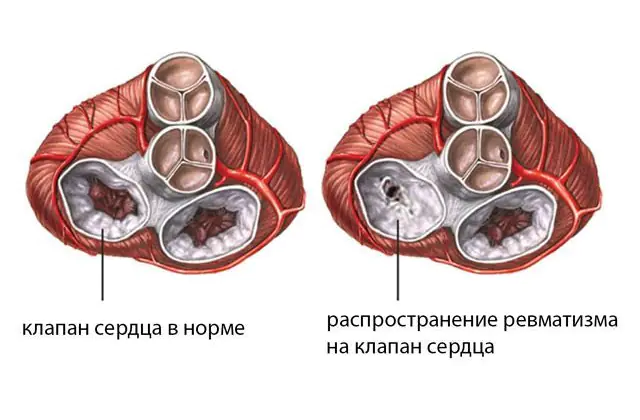
What is rheumatic carditis, causes and symptoms of the disease. Classification, diagnostic measures. Traditional and surgical treatment.
The content of the article:- What is rheumatic carditis
- Reasons for development
- Main symptoms
- Diagnostic methods
- Treatment options
- Medicines
- Physiotherapy
- Diet
- Surgical intervention
- Folk remedies
- Prevention measures
Rheumatic carditis is an inflammatory process in the connective tissue of the heart, which affects various layers of the organ and the heart valve. The disease is manifested by impaired blood circulation and heart function, which affects the condition of other organs and tissues. Traditional and surgical methods are used for treatment.
What is rheumatic carditis?
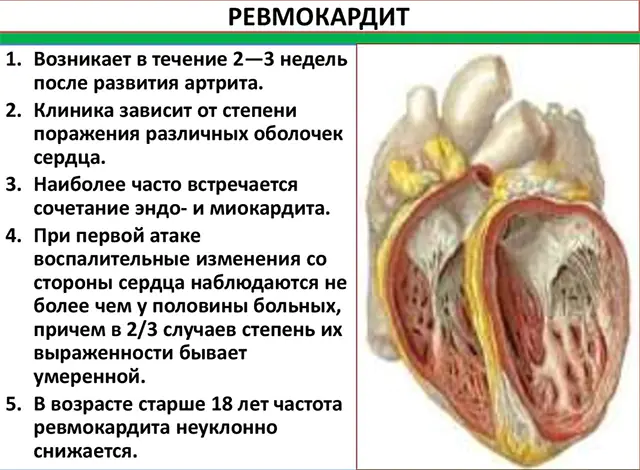
Rheumatic carditis of the heart or rheumatic carditis is not considered by doctors as an independent disease. The pathology develops as a complication after a streptococcal infection.
The disease affects men and women equally. After the first signs of rheumatism, a complication develops in 80% of children and 90% of adults. After a relapse, the disease manifests itself in 100% of patients, and there is a high risk of heart defects.
In Russia, primary rheumatic attacks occur in 1 child in 3000 children. Among adolescents 7-15 years old, the development of rheumatic carditis occurs in 80% of cases after acute rheumatic fever, but heart disease develops in only 1% of children, subject to timely treatment of the infection. Girls aged 6 to 15 years get sick 2-3 times more often than boys.
Types of rheumatic carditis are determined by location, severity of development and time of manifestation. Depending on when and under what conditions the disease developed, primary and secondary types are distinguished. Primary forms after illness caused by streptococcal infection, and against the background of rheumatic fever. The mitral valve is affected and stenosis develops. The functioning of the liver and kidneys deteriorates. Primary rheumatic carditis often leads to the formation of valve disease.
Recurrent rheumatic carditis is characterized by the same clinical picture, but develops in the form of a relapse or against the background of existing heart defects. Joint pain and deterioration of the mitral valve join the general symptoms.
Depending on how rapidly the disease develops, acute and chronic types are distinguished. Acute rheumatic carditis is characterized by a sudden appearance and rapid development. Arthritis, disruption of the nervous system, and skin pathological changes occur.
The chronic type of rheumatic carditis is characterized by a long course, lasting six months. There are no clear symptoms. Due to its sluggish course, the disease is not diagnosed in a timely manner, and treatment begins too late.
The layer of the heart membrane affected by the infection determines the type of disease by location:
- Pericarditis. The inflammatory process occurs in the pericardium (the outer lining of the heart), the affected “leaves” of which grow together. In the case of effusion pericarditis, fluid accumulates in the membrane, swelling of the neck and face occurs, pressure drops, due to stagnation of bile, heartburn is felt, pain in the stomach, and nodular rashes appear on the skin.
- Myocarditis. The inflammation is localized in the heart muscle - the myocardium. The disease can manifest itself in one area or cover a large area. With myocarditis, chest pain appears even at rest, arrhythmia is alarming, and a systolic murmur is recorded when listening. The disease becomes severe if the infection affects the entire layer of the myocardium.
- Diffuse myocarditis. The disease can be fatal. It is acute, fever sets in, there is severe pain in the left chest, it is difficult for the person to move, and there is a risk of loss of consciousness. The patient's face reflects intense suffering and a feeling of fear. During an attack, people take a position in which the pain is felt less pronounced. Sometimes there is a cough with blood, the vessels in the neck pulsate, and due to disturbances in the functioning of the liver, the stomach bulges.
- Recurrent myocarditis. The disease occurs secondary to existing heart defects: valve prolapse, fused pericardial layers, scars. Symptoms differ little from the primary form of pathology. Relapses appear acutely or are sluggish, often accompanied by liver damage.
- Endocarditis. With this type of disease, the valve apparatus is affected. In place of damaged tissue, scars appear that do not fully perform the function of the valve. The consequence is the growth of the heart chambers, which is manifested by swelling, dizziness, pale skin, accumulation of fluid in the peritoneum, cough, shortness of breath. The prognosis for endocarditis is unfavorable.
- Pancarditis. This is the name for multiple lesions of the membranes of the heart. The disease is difficult to treat.
Reasons for the development of rheumatic carditis

The causative agent of the disease is group A beta-hemolytic streptococcus (another name is GABHS infection). The bacterium gives rise to diseases in the body such as tonsillitis, scarlet fever, sinusitis, tonsillitis. If the treatment of these pathologies is carried out at the wrong time or inadequately, the infection spreads to other organs, including the heart, causing an inflammatory process.
The body's acute reaction to streptococcal infection is caused by allergies. When infected with a bacterium, the immune system begins an active fight against the pathogen, recognizing streptococcus by certain molecules. The same molecules are present in the body. As a result, the immune system begins an attack against the cells of the human body.
Important! When infected with other viruses or bacteria, rheumatic carditis does not develop.Indirect causes of rheumatic carditis that stimulate the development of pathology are:
- long-term treatment with immunosuppressants;
- weakened immune system;
- unsanitary working or living conditions;
- existing heart disease;
- hereditary predisposition;
- regular stress;
- frequent hypothermia.
In children, rheumatic carditis often develops after pneumonia, scarlet fever or tonsillitis. The first symptoms occur against the background of rheumatic joint damage, although the child may not complain of pain in the limbs.
Rheumatic carditis in adults develops with the same frequency as in children. In children, the risk of infection increases due to an imperfect immune system and frequent childhood illnesses. An additional factor is the large crowding of children in kindergartens and schools.
Symptoms of the development of rheumatic carditis

Signs of rheumatic carditis appear 2-3 weeks after infection with streptococcus. The disease makes itself felt by an increase in body temperature, sometimes up to 38-39 degrees, fatigue, general weakness, and sweating.
After a week, symptoms of heart damage appear:
- shortness of breath in any position;
- rapid heartbeat (up to 100 beats per minute);
- soreness in the chest area;
- swelling of the legs caused by heart failure;
- poor appetite;
- pale skin;
- nosebleeds;
- fever.
Over time, the infection spreads to other organs and tissues. Symptoms of rheumatic carditis are complemented by pain in the joints and a wet cough of cardiac etiology. Internal organs increase in size.
Depending on the intensity of the symptoms, there are 3 degrees of severity of the pathology:
- Lightweight. Signs of the disease are absent or appear slightly. No changes in the heart are diagnosed.
- Moderately intense. Blood circulation is not impaired, but an enlarged heart is recorded. Some typical signs of rheumatic carditis appear.
- Heavy. The inflammatory process covers all the membranes of the heart, and symptoms become more pronounced. The volume of the organ is maximally increased, blood circulation is impaired.
In the early stages, the disease may be asymptomatic. The degree of manifestation of signs of pathology depends on the severity of damage to the heart wall.
Important! Like rheumatism, rheumatic carditis requires careful diagnosis. Only after diagnosis can treatment of the disease begin.Methods for diagnosing rheumatic carditisA
Diagnosis of rheumatic heart disease begins with examining the patient by a cardiologist and listening to heart rhythms. The doctor assesses the condition of the patient’s skin, checks for swelling and shortness of breath. In the conversation, the doctor finds out what infectious diseases the patient suffered in the recent past, what treatment he underwent, and asks about the symptoms of heart damage.
To confirm the diagnosis, instrumental studies are recommended:
- phonocardiogram (recording of heart murmurs);
- Ultrasound of the heart;
- chest x-ray;
- ECG (recording of heart rhythms).
Laboratory tests for rheumatic heart disease include:
- sowing of the nasopharyngeal mucosa to identify the pathogen and its sensitivity to antibacterial drugs;
- blood test (the results are characterized by an increase in the number of leukocytes, ESR);
- test for the presence of antibodies to streptococcus in the blood.
Rheumatic carditis is differentiated with the following pathologies:
- cardiomyopathy;
- viral myocarditis;
- valve damage in lupus erythematosus.
If the diagnosis is confirmed, consultation with a rheumatologist is required.
Treatment methods for rheumatic carditis
For rheumatic heart disease, treatment takes place in a hospital. The patient is recommended to rest in bed for a month. Complex therapy is carried out aimed at relieving inflammation and eliminating the pathogen. Surgery is used in cases of severe heart defects and the absence of results from traditional treatment.
Medicines for the treatment of rheumatic carditis
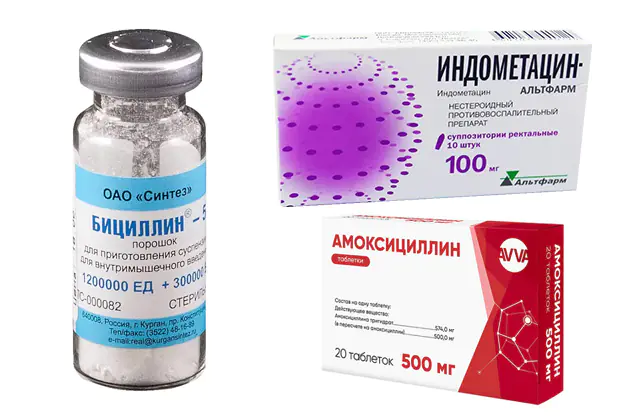
Drugs for rheumatic heart disease are administered by injection or taken orally. The treatment regimen is traditional and includes the following medications:
- Antibiotics. At the first stage, Penicillin is administered followed by a transition to Bicillin (price - 20 rubles or 8 hryvnia per ampoule). Then Amoxicillin or Oxacillin is prescribed orally (price - 250 rubles or 100 hryvnia). If you are intolerant to these drugs, Erythromycin or Cephalexin is recommended (price - 200 rubles or 90 hryvnia).
- Non-hormonal anti-inflammatory drugs. Medicines are used to relieve the inflammatory process. These include Aspirin, Ibuprofen, Indomethacin (price - 50 rubles or 20 hryvnia). The drugs thin the blood and prevent the development of complications.
- Quinolones. These include Plaquenil and Delagil. The drugs are used for relapses of the disease. Together with quinolones, salicylates are prescribed (Acetylsalicylic acid, Aspirin, price - 40 rubles or 15 hryvnia).
- Glucocorticosteroids. These are hormonal medications that relieve inflammation in a severe stage. For rheumatic carditis, Prednisolone, Triamcinolone, Dexamethasone are usually recommended (price - 32 rubles or 17 hryvnia).
- Diuretics. This category includes Indapamide, Lasix (price - 100 rubles or 40 hryvnia). The drugs are prescribed for swelling of the legs, face, and neck.
- Cytostatic immunosuppressants. Medicines of this group are used for constant relapses or long-term pathology. They are recommended only in the absence of results from treatment with glucocorticosteroids and non-steroidal drugs. Cytostatics include Imuran, Chlorbutin (price - 2500 rubles or 1000 hryvnia).
- Gamma globulin in combination with desensitizing medications(Diphenhydramine, Diazolin, Tavegil, price - 46 rubles or 18 hryvnia). Medicines relieve an allergic reaction, but they are not prescribed for the acute course of the disease.
- Ascorbic acid. To strengthen the immune system and thin the blood, vitamin C is administered in large quantities.
Treatment of childhood rheumatic carditis follows the same scheme as in adults. The dosage of antibiotics is selected taking into account the age and weight of the patient. Hormonal drugs are prescribed in exceptional cases when non-steroidal anti-inflammatory drugs are powerless.
All medications for rheumatic carditis are taken in a comprehensive manner and prescribed individually depending on the diagnosis.
Physiotherapy for rheumatic carditis

To consolidate the results of treatment, physiotherapeutic procedures are used:
- massage of the limbs to improve blood circulation and eliminate physical inactivity;
- electrophoresis with antibacterial medications;
- UHF;
- radon, hydrogen sulfide, sodium chloride and carbon dioxide baths;
- healing mud;
- ultraviolet.
Baths and mud therapy are especially effective during the remission stage. For heart defects, baths with hydrogen sulfide or carbon dioxide are recommended. If rheumatic heart disease is sluggish, radon baths will help.
When the disease subsides, the patient is advised to undergo sanatorium treatment to maintain the condition.
Diet for the treatment of rheumatic carditis

A mandatory element of the treatment of rheumatic carditis is diet. The patient should eat foods with sufficient amounts of animal and vegetable fats and protein.
The daily amount of food is divided into 5-6 small portions. You should not overeat: excess stress on the stomach has a negative effect on the functioning of the heart.
Much attention is paid to vegetables and fruits in the diet. Getting enough potassium, which is found mainly in foods of plant origin, is important for the heart. An important element of the diet is millet cereal, which contains potassium in abundance.
An equally important element for heart function is calcium. For its intake into the body, dairy products, sesame seeds, and bell peppers will be useful. To strengthen the myocardium, protein is required, which is found in eggs, meat, fish, and legumes.
Fried foods should not be on the menu. Products are prepared by boiling, baking or steaming. To prevent complications and obesity, it is recommended to give up coffee, sweets, pickles, baked goods, and flour products.
Surgical intervention for rheumatic carditis
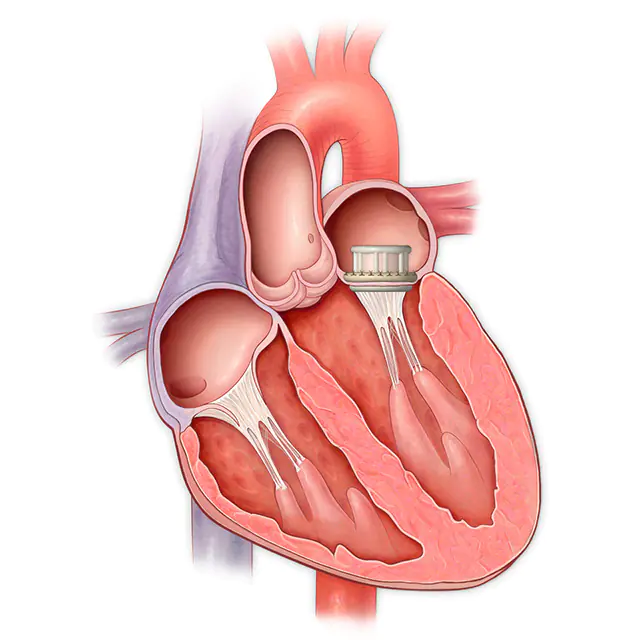
Pictured is mitral valve replacement
Surgery is used for severe heart defects if they cause irreversible changes in the functioning of internal organs that are not amenable to traditional therapy.
If the valve is damaged, the following types of surgical intervention are used:
- Mitral commissurotomy. The operation is performed for valve stenosis (fusion of the leaflets). The valves are dissected using a closed or open method. The latter requires the connection of artificial circulation.
- Valvuloplasty. The method is used to narrow the valve. Under local anesthesia, a catheter with a balloon is inserted into the patient through the femoral artery. The instruments are placed in the heart, and when air is supplied to the balloon, the valve expands. The catheter is then carefully removed.
- Valve replacement. For severe heart defects, biological or mechanical prostheses are installed. Their service life ranges from 10 to 15 years.
After surgery, the patient undergoes a long rehabilitation period.
Folk remedies against rheumatic carditis
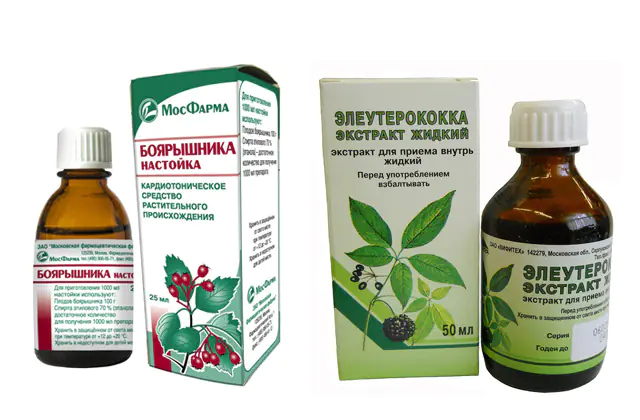
Traditional medicine recipes for rheumatic carditis are aimed at strengthening the heart muscle and immunity. Combine natural medicines with traditional medicines:
- Hawthorn tincture. Suitable for people suffering from high blood pressure. To prepare the tincture, take 2 parts of dried leaves of the plant to 10 parts of alcohol. Wait a week. Take 40 drops three times a day half an hour before meals.
- Eleutherococcus tincture. Pour 50 g of roots with 0.5 vodka. After 2 weeks, drink 40 drops of the tincture half an hour before meals.
- Chokeberry. Pour 1 tbsp. l. berries with a glass of boiling water and cook for 1.5 minutes. Let the infusion stand for an hour. Drink half a glass three times a day.
- Nettle. 1 tbsp. l. leaves pour 1.5 tbsp. boiling water Boil for 10 minutes, then leave for 10 hours. Drink 100 ml of decoction half an hour before meals for a month.
Measures to prevent rheumatic carditis

In rheumatic heart disease, the heart valve is destroyed. In 20%, the disease leads to the formation of heart disease. There is a risk of heart attack or stroke due to the accumulation of blood clots on the inner lining.
The greatest danger is heart failure. The disease can be hidden and not bother you, but as a result, sclerosis of the heart muscle occurs.
Arrhythmia develops against the background of chronic rheumatic carditis. The situation can cause cardiac arrest. The prognosis for the course of the pathology depends on how timely the diagnosis was made and medical care provided.
To avoid the development of rheumatic carditis and its complications, adhere to the following measures:
- strengthen your immune system by hardening and physical exercise;
- Make sure your nutrition is complete;
- avoid prolonged hypothermia;
- pay attention to the treatment of infectious diseases;
- monitor your heart condition;
- Get a routine check-up with your doctor every six months.
Rheumatic carditis is a serious inflammatory process that can even lead to death. Negligence regarding one's health results in severe pain in the heart and the need to undergo long-term treatment.
Video about rheumatic heart disease:



